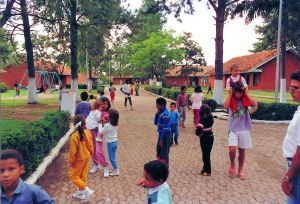Child Sponsorship Background from Porto Alegre, Brazil
 SOS Children's Village Porto Alegre
SOS Children's Village Porto Alegre
The first SOS Children's Village in Brazil opened its doors to orphaned and abandoned children in April 1967. This SOS Children's Village was built on a six-acre site on the outskirts of Porto Alegre. It consists of twelve family houses, where up to 90 children can find a new home. There is also the village director's house, a house for the so-called SOS aunts (SOS mother trainees or family helpers who support the SOS mothers during their daily work and fill in for them when they are ill or on leave), and an administration and service area. Children from the SOS Children's Village usually attend the local state schools.
Other SOS Projects in Porto Alegre
On the site of the SOS Children's Village, there is also an SOS Nursery School, which is open to children from the local community as well. Many children can be taught at the SOS Nursery School. An SOS Youth Home in the city centre accommodates up to young adults from the SOS Children's Village. Young people usually move from the SOS Children's Village to an SOS Youth Home when they start a vocational training course or go on to higher education. With the support of qualified youth workers, the young people develop realistic perspectives for their future, learn to shoulder responsibility and increasingly make their own decisions. They are encouraged to develop team spirit and build up contacts with relatives and friends, as well as with the relevant authorities and potential employers.Background to Porto Alegre
Porto Alegre lies on the eastern bank of Lake Guaiba (Rio Guaiba), where five rivers converge to form the Lagoa dos Patos (Lagoon of the Ducks). It is the tenth highest populated municipality in Brazil, and the capital city of the Brazilian state of Rio Grande do Sul with over four million residents

 Return to Schools Wikipedia Home page…
Return to Schools Wikipedia Home page…
